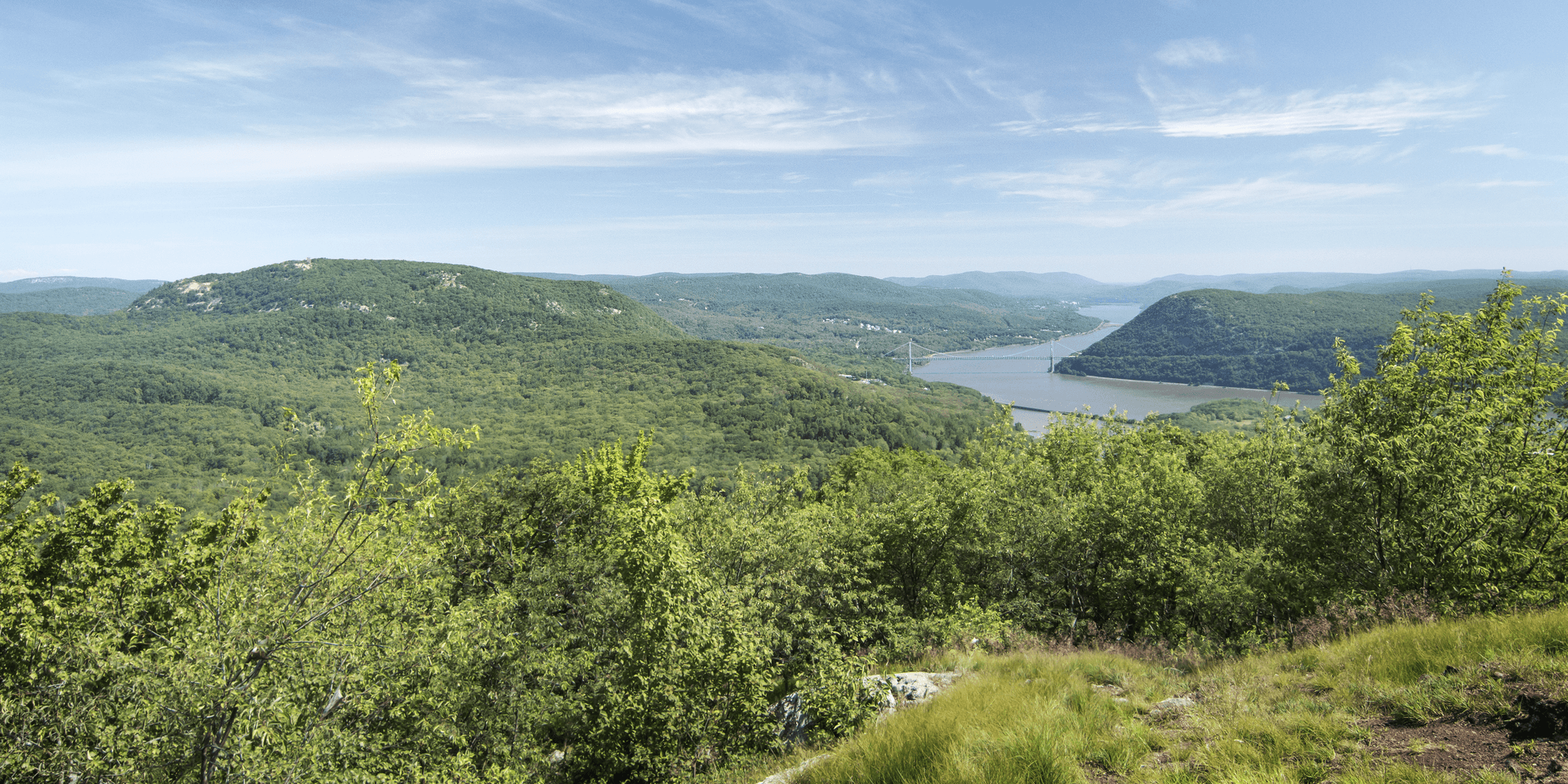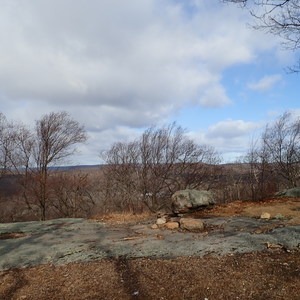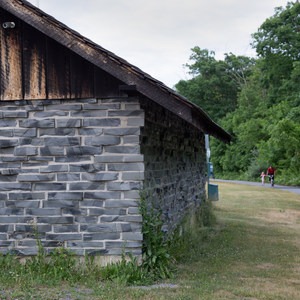You are here
Bald Mountain is one of several mountains in the historic 5,205-acre Bear Mountain State Park. It lies at the border of Stony Point in Rockland County, and it boasts incredible views of the entire park that stretch to the west over Harriman State Park and north up the Hudson River Valley. This very steep 1,300-foot ascent is a 3.75-mile there-back trek with an average slope grade of more than 15-percent. It covers the blue-blazed "Cornell-Mine Trail" to the peak, but there are several other trails that can be used to reach the summit. The New York State Office of Parks, Recreation and Historic Preservation (NYS OPRHP) has a published map to help you navigate your route.
The Cornell-Mine Trailhead is on Route 202 a short distance north of Iona Island and to the south of the entrance to the Bear Mountain Inn at Hessian Lake. There is a small dirt parking area on the river side of the road, and the blue-blazes begin slightly to the north on the left side of a minor bridge over the Doodletown Creek. Enter the woods, pass through some high brush, and emerge to a small waterfall and pool. The trail continues to the left of the water and heads uphill to the south. The ascent is very rocky with large boulders and glacial erratics scattered around the mountain. To your right, you will hear the Doodletown stream and water flowing over an old concrete damn. Further up the stream there is another waterfall under a former road bridge on an unmarked trail. You can venture off the path and down the steep hill for a closer look at each of these, but be careful not to miss the blue-blazes upon returning to the main path.
At this point, the trail continues with a gentle ascent on a wider worn path that is a former mining road. More large boulders seem awkwardly placed as you ponder the thousands of feet of ice that towered over this region in the last ice age. The Edison Mine is another divergence worth exploring: It lies a short distance off the path to the west at the top of a minor hill. This mine was an experiment by Thomas Edison that took place during the 1890s and trialed a new method for extracting iron ore using electromagnets. The invention didn't yield the desired results, and the remaining exploratory pit extends several yards into the earth. Return to the blue-blaze trail markers.
The path will suddenly reach a very steep and rocky incline at the base of Bald Mountain. This entire mountainside is very rocky with large boulders that are the remains from operations at the Cornell Mine. The mine is named after United States senator Thomas Cornell who also served as president of the Cornell Steamship Company and the Ulster and Delaware Railroad. Cornell Mountain in the Catskills also bears this senator’s name. This grueling ascent climbs over 600-feet in three-quarters of a mile, equating to an average slope of more than 25 percent. There are a few switchbacks, and they are easy to miss as you are focus on your footing.
Climbing higher, you will get your first glimpse of Perkins Memorial Tower at the summit of Bear Mountain to the north. As the path begins to level off, the Cornell-Mine Trail ends and intersects the red-blazed Ramapo-Dunderberg Trail. Take a right onto this path and circumnavigate to the 1,130-foot summit of Bald Mountain. This high region of the Hudson Valley has scattered tree cover surrounded by lush grasses and beautiful mountain laurel which bloom in late June. With its sparsely wooded peak and rock ledges, Bald Mountain offers fantastic views of the surrounding area: To the west you can see the 1,080-foot summit of the Timp, which lies on the border of Harriman State Park; to the north, you may be able to see visitors at the top of Bear Mountain checking out the tower and enjoying views that stretch to the Manhattan skyline over 50 miles to the south. The valley between Bald Mountain and Bear Mountain is home to the ghost town called Doodletown: a small, isolated community settled in the 1760s by loggers and miners that had residents until 1965 and has old foundations and cemeteries that can still be explored. The Bear Mountain Bridge spans the Hudson River to the north with Anthony’s Nose at its eastern end. The scene continues up to the West Point Military Academy and the bend in the river around Constitution Island. From here you can descend Bald Mountain on the same path, continue on this path down to the 1777 trail for a longer loop through Doodletown, or continue to the east over Dunderberg Mountain to Jones Point and the foundations of an old railroad bed that was never completed. Refer back to the park’s map for additional route information.
Historic Trails
Throughout the years of the American Revolution, the Hudson River was considered to be an essential waterway for controlling the colonies. In 1777, British forces marched over Dunderberg from the west and attacked Forts Clinton and Montgomery. They overwhelmed American troops and killed nearly 300 patriots who were thrown into Hessian Lake, then called Bloody Pond. You can walk along this historic route from the western side of Bear Mountain State Park all the way to Hessian Lake on the 1777 Trail, which was built between 1974 and 1975 as a joint project between the Rockland County Boy Scouts, the Palisades Interstate Park, the Rockland County Cooperative Extension and the New York-New Jersey Trail Conference. The route re-creation was determined from British military records and maps drawn by Major Robert Erskine, Surveyor General of the Continental Army, and by Jack Mead of the Trailside Museum at Bear Mountain.)
Bear Mountain State Park
Bear Mountain State Park offers a fantastic array of opportunities for biking, hiking, boating, picnicking, swimming, cross-country skiing, cross-country running, sledding and ice skating. It was conceived by George Perkins as a place of “rest and relaxation” and a getaway from New York City, and it includes Bear Mountain, Dunderberg, and the West Mountains. Mary Averell Harriman, wife of Edward Harriman, gave 10,000 acres of land to the state under the condition that they discontinue plans for the construction of Sing Sing prison at the base of Bear Mountain (it was eventually built down river in Ossining). Millions of outdoor enthusiasts have enjoyed this area since its opening in 1913. Be sure to check out the Bear Mountain Zoo across the street from Hessian Lake! Today it is managed by the Palisades Interstate Park Commission and enjoyed by over half a million people each year.
Transportation
The Shortline Bus has a stop near Hessian Lake on a line route to and from New York City.








Comments
Sign In and share them.